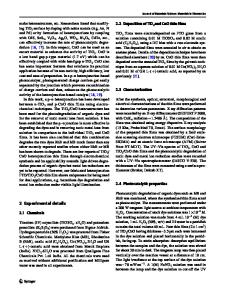Synthesis of N and S Co-doped TiO 2 Nanotubes for Advanced Photocatalytic Degradation of Volatile Organic Compounds (VOC
- PDF / 1,463,336 Bytes
- 9 Pages / 595.276 x 790.866 pts Page_size
- 8 Downloads / 365 Views
ORIGINAL PAPER
Synthesis of N and S Co‑doped TiO2 Nanotubes for Advanced Photocatalytic Degradation of Volatile Organic Compounds (VOCs) in Gas Phase Le Thi Hoang Yen1 · Doan Van Thuan2,3 · Nguyen Thi Hanh1 · Nguyen Hoang Thao Vy1 · Tran Thi My Hang1 · Hoang Van Ha4 · Thanh‑Dong Pham4,5 · Ajit Kumar Sharma6 · Minh‑Viet Nguyen4,5 · Nhat‑Minh Dang4,5 · Nguyen Thi Thanh Truc7
© Springer Science+Business Media, LLC, part of Springer Nature 2020
Abstract In this study, sol–gel combining with hydrothermal methods were successfully used to synthesize N and S co-doped TiO2 nanotubes (N@S-TiO2 NTT) for efficient photocatalytic degradation of volatile organic compounds (VOCs). The obtained characterization results indicated that the synthesized N@S co-doped TiO2 existed as nanotubes. Specific surface areas of these synthesized nanotubes was greatly that of these nanoparticles. The largest surface area recorded at N@S-TiO2 nanotubes was 105.3 m 3/g. FTIR spectrum results showed that the presence of N–H and S–O bond, which confirmed that nitrogen and sulfur were successfully doped into T iO2 lattice. We also investigated that N@S dopants significantly improved the photocatalytic activity of TiO2 nanotubes for efficient degradation of gaseous VOCs. Therefore, photocatalytic activity for VOCs degradation by the N@S-TiO2 nanotubes was greater than that by the undoped TiO2 nanotube. Optimized humidity for degradation of VOCs was medium condition (55–70%). Under dry conditions, lack of water for hydroxyl radical production led to decrease in photocatalytic activity. Under humidity conditions, the excess water molecules competed with VOCs for adsorbing on material surface leading to decrease in photocatalytic degradation efficiency. Under the optimized humidity, the highest photocatalytic efficiency of the synthesized N@S-TiO2 nanotubes for degradation of gaseous VOCs for 3 h was approximately 94%. The VOCs degradation capacity by the synthesized N@S-TiO2 nanotubes was approximately 90 (ppm/g h). Keywords N@S co-doping · Nanotubes · Hydrothermal · TiO2 · Vocs removal
* Nguyen Thi Thanh Truc [email protected] 1
5
VNU Key Laboratory of Advanced Materials for Green Growth, University of Science, Vietnam National University, 334 Nguyen Trai, Thanh Xuan, Hanoi, Vietnam
Faculty of Environmental Sciences, Hanoi University of Science, 334 Nguyen Trai, Thanh Xuan, Hanoi, Vietnam
6
2
NTT Hi‑Tech Institute, Nguyen Tat Thanh University, Ho Chi Minh City 700000, Viet Nam
School of Chemical Engineering and Physical Science, Lovely Professional University, Jalandhar, India
7
3
Center of Excellence for Green Energy and Environmental Nanomaterials (CE@GrEEN), Nguyen Tat Thanh University, Ho Chi Minh City 700000, Viet Nam
Faculty of Environment and Labour Safety, Ton Duc Thang University, Ho Chi Minh City, Vietnam
4
Faculty of Chemistry, University of Science, Vietnam National University, 334 Nguyen Trai, Thanh Xuan, Hanoi, Vietnam
13
Vol.:(0123456789)
1 Introduction VOCs such as alco
Data Loading...











